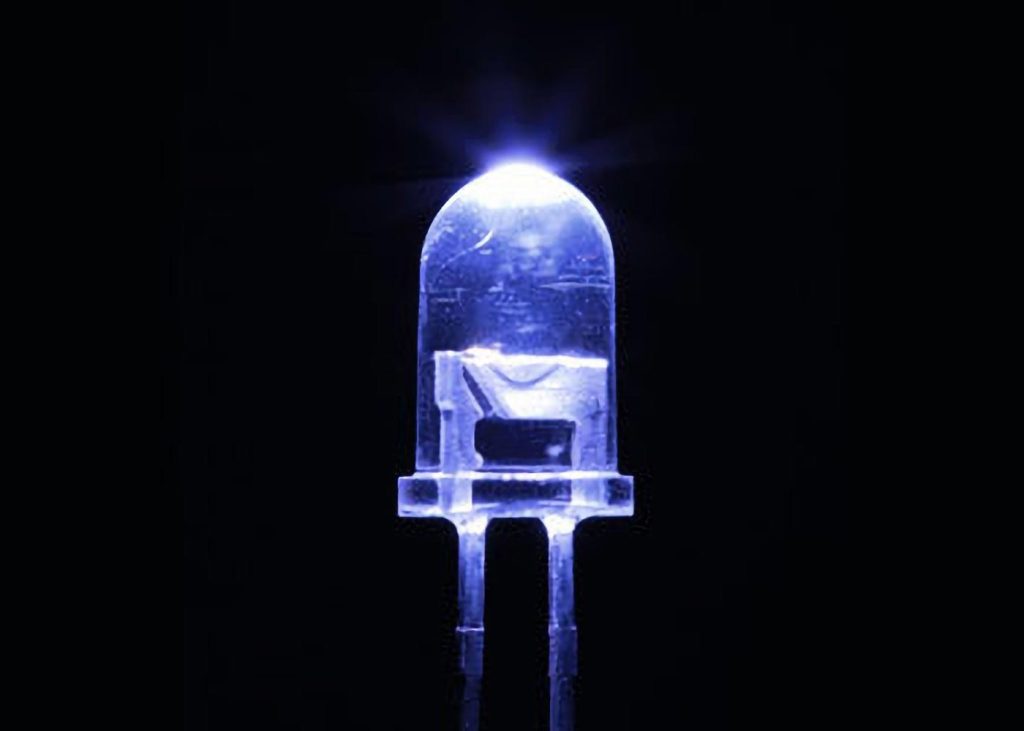

1. ábra: A legtöbb LED látható fényt bocsát ki, de a RIKEN fizikusai létrehoztak egy olyan LED-et, amely szűk tartományban bocsát ki távoli ultraibolya sugarakat, és biztonságos az emberek számára, de végzetes a vírusok és baktériumok számára. hitel: RIKEN
A nagy teljesítményű LED-lámpa hatékonyan fertőtleníti a felületeket, miközben megőrzi az emberek biztonságát.
A RIKEN fizikusai egy rendkívül hatékony LED-lámpát terveztek, amely antimikrobiális és vírusellenes, de biztonságos az emberek számára. Egy nap segíthet az országoknak kiemelkedni a járványok árnyékából, ha megöli a kórokozókat az emberekkel teli szobákban.
Az ultraibolya germicid lámpák rendkívül hatékonyak a baktériumok és vírusok elpusztításában. Valójában ezeket rutinszerűen használják a kórházakban orvosi felületek és műszerek sterilizálására.

Masafumi Jo és két munkatársa olyan LED-lámpát tervezett, amely segít megvédeni a társadalmat a járványoktól. hitel: RIKEN
Az ilyen típusú lámpákat LED-ekkel lehet létrehozni, ami energiatakarékossá teszi őket. Ezek a LED-lámpák azonban káros tartományban bocsátanak ki ultraibolya fényt[{” attribute=””>DNA and therefore cannot be used around people. The search is on to develop efficient LEDs that shine light within a narrow band of far-ultraviolet light that appears to be both good at disinfecting while remaining safe for people.
Germicidal LED lamps that operate in the absence of humans are often made from aluminum, gallium, and nitrogen. By increasing the amount of aluminum they contain, these LEDs can be modified to work in a wavelength region that is safe for humans. This approach has been used before but has resulted in dramatically reduced power.
To work through this issue, three physicists at RIKEN Quantum Optodevice Laboratory, Masafumi Jo, Yuri Itokazu, and Hideki Hirayama, created an LED with a more complex design. They sandwiched together multiple layers, each containing slightly different proportions of aluminum. In addition, in some layers they also added tiny amounts of silicon or magnesium.
This effectively created an obstacle course for electrons, hindering their movement across the material and trapping them for longer in certain areas. This resulted in an increased amount of light emitted by the device and a reduced amount absorbed by it.
The team used computer simulations to model all possible effects to help pin down the ideal design. “We then grew samples to see if it was effective or not,” Jo says. Precisely controlling the thickness of each layer was the biggest experimental challenge. They ended up with an LED operating in the far ultraviolet, with an output power almost ten times higher than their previous best.
The COVID-19 pandemic brought a new consciousness of the importance of being able to eradicate viruses and microbes on surfaces. “We trust that our findings and technologies will be very useful for safeguarding society against this and future pandemics,” says Jo.
Jo adds that the trio will strive to improve their LED’s performance even further. “There’s still much room for improvement in the output power and the power efficiency,” he notes.
Reference: “Milliwatt-power far-UVC AlGaN LEDs on sapphire substrates” by Masafumi Jo, Yuri Itokazu and Hideki Hirayama, 25 May 2022, Applied Physics Letters.
DOI: 10.1063/5.0088454

„Utazási specialista. Tipikus közösségi média tudós. Az állatok barátja mindenhol. Szabadúszó zombinindzsa. Twitter-barát.”





More Stories
A SpaceX Polaris Dawn űrszondájának legénysége a valaha volt legveszélyesebb űrsétára készül
Egy őskori tengeri tehenet evett meg egy krokodil és egy cápa a kövületek szerint
Egyforma dinoszaurusz-lábnyomokat fedeztek fel két kontinensen